If you need to improve or expand your network range, you have two options. The first is adding an extender, and the second is a mesh Wi-Fi system. An extender, otherwise known as a repeater, retransmits your Wi-Fi’s data stream, while a mesh router is designed to use satellite routers that act as a Wi-Fi hub in whichever room they are located.
Both options will improve a weak connection over a broad area, but mesh Wi-Fi system are better for a full replacement, and they're generally easier to set up, making them a great pick to deal with dead zones, larger public spaces, and big houses. There are plenty of affordable mesh network options, and even Wi-Fi 6 and Wi-Fi 6E models available for tech enthusiasts.
Here’s a list of the best mesh Wi-Fi systems on the market today, starting with Nest's excellent app-managed mesh routers.




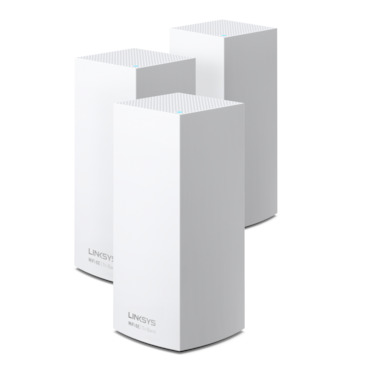




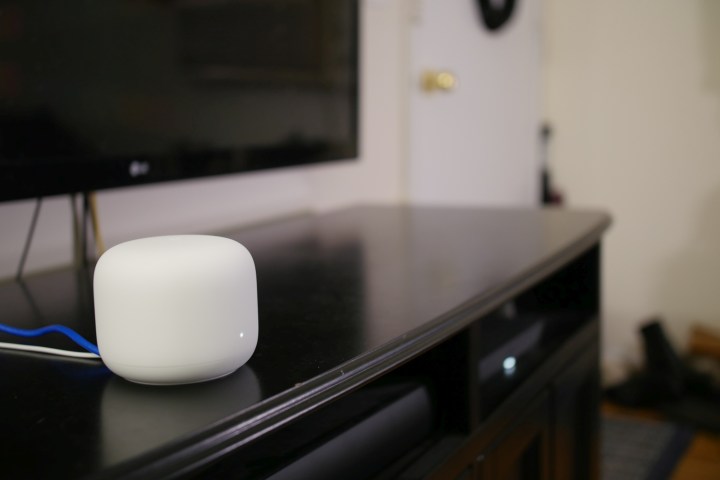
Best all-around mesh Wi-Fi system
Google Nest WiFi
- Simple installation and setup
- Google Assistant integration
- Ability to expand coverage
- Contemporary design fits any decor
- Somewhat expensive
- Single ethernet port
Why you should buy this: Google Nest delivers great Wi-Fi coverage in a well-designed package that fits into most homes.
Who's it for: Home users who don't want to mess with complex Wi-Fi settings and who value ease of use.
Why we picked the Google Nest mesh system:
The Nest Wi-Fi system is a mesh Wi-Fi solution that offers aC2200 speeds designed for large spaces – two models can cover as much as 4,400 feet when linked together, and you can make the system larger or smaller depending on how many units you buy. We liked Google's first attempt at mesh Wi-Fi for its ease of use, but Nest Wi-Fi makes it even easier to set up and manage the router, especially if you have any experience with the Google Home app.
They're also smart. Specifically, they have speakers and include Google Assistant, so you can give them voice commands and use them throughout the day (as opposed to most routers, which just sit there). The speakers aren't quite big enough for impressive music, but they're great for changing your schedule or getting updates and answers to your questions. If you have other Nest or Google Assistant devices around the home, then you also can control them via these routers. You can read more details in our full review.
Note that you have options to buy anywhere from one to three units of Nest WiFi depending on the space that you want to cover. Also, if Wi-Fi 6 is a must-have for you (and it's quickly becoming a necessity in new routers), then you may want to wait: Google has plans for a Wi-Fi 6 mesh router system, but it hasn't been released quite yet.

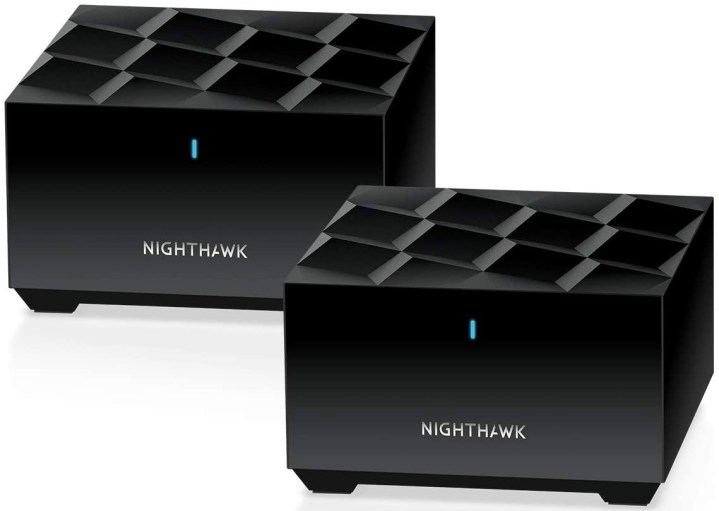
Best mesh Wi-Fi system for gaming
Netgear Nighthawk MK62
- Fast speeds for gamers and streamers
- Wi-Fi 6 support at a great price
- Easy to use
- Limited Ethernet ports
Why you should buy this: Netgear's Nighthawk delivers fast speeds and can blanket a large area with great signal.
Who's it for: Gamers and streamers who value speed.
Why we picked the Netgear Nighthawk MK62:
The Nighthawk line also has a highly capable mesh router, and if you've used a Nighthawk router before, then you know the app is highly capable when it comes to monitoring your system, making settings changes, and enabling more security. The AX1800 router supports coverage of up to 3,000 square feet with its included satellite and can handle more than 25 devices.
The dual-band router can offer speeds up to 1.8Gbps across four Wi-Fi streams, plus two Gigabit Ethernet ports (one per device) for wired connections that may require higher speeds or more reliability.
The Netgear Nighthawk MK62 router is also Wi-Fi 6 ready, so if you have compatible Wi-Fi 6 devices, you can enjoy the big boost in bandwidth. Even if you don't, the router still supports beamforming and MU-MIMO for older devices.

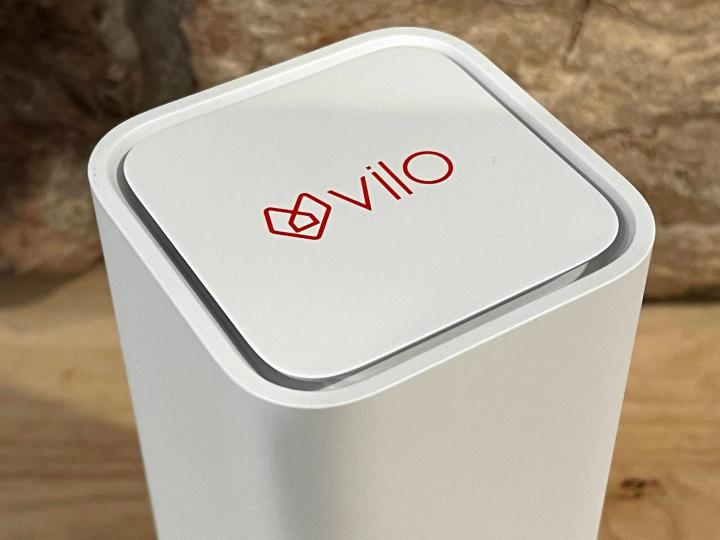
Best affordable mesh Wi-Fi system
Vilo Mesh Wi-Fi
- Affordable price
- Easy setup with intuitive app
- Plenty of Ethernet ports to get wired connection
- Compact, attractive design that’s expandable
- No Wi-Fi 6 support
- Some speed and connection issues
- No WPA3 support
Why you should buy this: Vilo makes getting started with a mesh network simple and affordable.
Who's it for: Home users on a budget who want to get started with a mesh network.
Why we picked Vilo's mesh Wi-Fi network:
Vilo's mesh network may not sound as impressive as some of its more modern contemporaries on this list – the system tops out at Wi-Fi 5 support and it doesn't support WPA3 security protocols – but at $20 for a single node or $60 for a complete multipack mesh system that can blanket a home as large as 4,500 square feet, it's the most affordable pick. At that price, it makes Vilo's mesh network a great option for those dipping their toes into the mesh ecosystem, and given that most electronics that you own aren't Wi-Fi 6 ready yet save for the newest smartphones and laptops, being constrained to Wi-Fi 5 may not be so bad if it means saving a few hundred dollars.
Like its more expensive competitors, Vilo's system benefits from an easy-to-use app that you will use to set up the network, establish parental controls, and create a guest network. Vilo's app appears to be more advanced than some others on the list — the guest network, for example, can expire after a set number of hours. Firmware updates are downloaded in the background to ensure that everything runs smoothly, and the router's compact size keeps it out of view if you don't want unsightly tech in your living space.

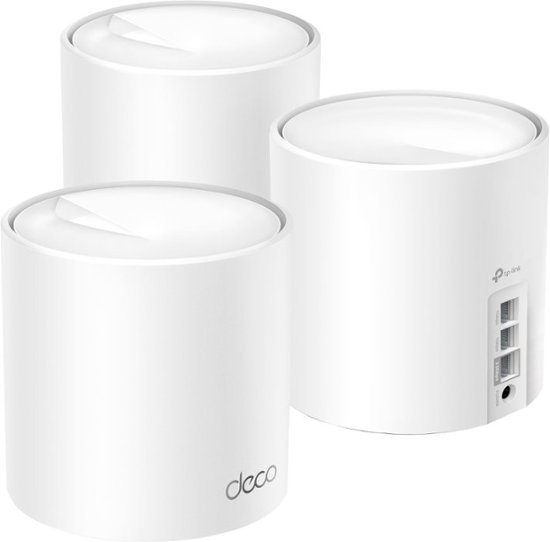
Best compact mesh Wi-Fi system
TP-Link Deco AX4300 Pro
- Covers up to 7,000 square feet and 150 devices
- Wi-Fi 6
- Voice assistant compatibility
- Affordable for its feature set
- May be overkill for some homes
Why you should buy this: TP-Link's Deco Pro allows up to 150 devices to be connected at any time.
Who's it for: Home users looking to host a network of Internet of Things (IoT) devices.
Why we picked the TP-Link Deco AX4300 Pro:
The set of three Deco Pro devices can extend a wireless network up to 7,000 square feet and can connect more than 150 devices at once, which may be a nice feature for a public or business environment. It's ready for up to 2.5Gbps speeds, so the only question is if your internet can keep up.
The control options offer plenty of customization too, including device prioritization, filtering internet content, and Wi-Fi pausing for the kids. When left to its own devices, the Deco uses adaptive routing to choose what looks like the fastest connection for devices on a first-come, first-served basis. Plus, voice assistant support is included for both Alexa and Google Assistant if you want to give commands for certain network interactions.


Best Wi-Fi 6E mesh Wi-Fi system
Linksys Atlas Max 6E
- Elegant compact design
- Wi-Fi 6E network support
- Nodes and base can be interchanged
- Expensive
Why you should buy this: Linksys' Atlas Max 6E delivers strong Wi-Fi 6E coverage across a wide space in a very compact form factor.
Who's it for: Home users wanting a compact but advanced Wi-Fi 6E mesh Wi-Fi system that can fit in with their decor.
Why we picked the Linksys Atlas Max 6E:
Linksys needlessly made its mesh Wi-Fi lineup confusing, with distinct sub-brands that look similar and all serve to achieve one common goal: To blanket your home or workspace with reliable Wi-Fi coverage. Despite the confusing branding, the Atlas Max 6E packs the latest Wi-Fi 6E technology in a form factor that resembles the company's Velop mesh systems, which were among the first whole-home mesh products on the market. Unlike some other models in Linksys's lineup, the Atlas Max does not come with HomeKit support, but it does come with support for the new 6GHz band as part of the unit's tri-band antenna design for even more robust speeds. The Atlas Max retains the Velop's minimalist and simple design, allowing it to comfortably fit into any home.
Linksys claims that the 4x4 radio with MU-MIMO radio can blanket homes as large as 9,000 square feet with speeds up to 8.4Gbps, making this a future-proof investment for years to come for those who need the latest in Wi-Fi 6 or Wi-Fi 6E technology today. Linksys offers the Atlas Max 6E in varying configurations, and owners of larger homes may want to consider a three-pack unit for the best coverage. Unlike competing brands that ship their mesh system with a dedicated base router unit and purpose-built nodes or satellites, the best part about the Atlas Max 6E is that any of the units in the multi-pack can serve as the base or the node, making setup fool-proof and user friendly. The companion app will give you access to a plethora of features, security settings, and the ability to set up guest networks without overwhelming first-time users.

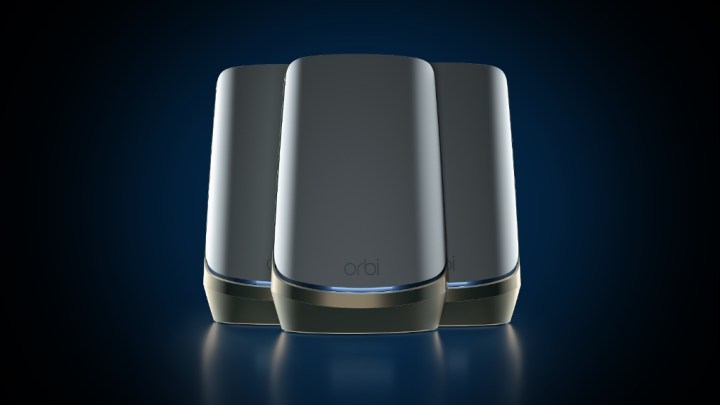
Best advanced mesh Wi-Fi system
Netgear Orbi RBKE963
- Solid quad-band connectivity
- Advanced Wi-Fi 6E support
- Plenty of Ethernet ports
- Bulky design
- Optional subscription drives up costs
- Expensive
Why you should buy this: Netgear's quad-band Wi-Fi 6E Orbi RBKE963 is perhaps the most advanced mesh Wi-Fi system on our list, delivering up to 10Gbps speeds and wide coverage.
Who's it for: Gamers, 4K/8K streamers.
Why we picked the Netgear Orbi RBKE963 Wi-Fi system:
Retailing for $1,500, Netgear's latest Orbi RBKE963 is perhaps the most expensive whole-home mesh networking solution on our list, but it packs enough punch to justify its premium price. The Wi-Fi 6E model replaces the company's prior Wi-Fi 6 Orbi on our list, and the update brings a lot of technology not found in cheaper alternatives, like a quad-band antenna setup that delivers up to 10.8Gbps of speed across your home. It's not the most discrete or compact mesh design on the market, but the company's engineers claimed that the larger design allows for bigger, better antennas to help deliver reliable Wi-Fi coverage. The three-pack solution – which includes a base station and two satellites — is capable of covering up to a 9,000-square-foot home, making it a powerful addition to larger living spaces and offices.
Netgear claims that the Orbi RBKE963 can deliver up to 16 simultaneous Wi-Fi streams for uninterrupted, buffer-free video and lag-free gaming, provided your home broadband plan is powerful enough to take advantage of this system's full potential. You can create multiple Wi-Fi networks with this solution to manage and secure your traffic, and Netgear says you can have a main home network, a guest network, a dedicated network for IoT devices, and a separate Wi-Fi 6E network for high bandwidth applications. Like most other mesh systems, the Orbi is controlled by a smartphone app, which gives you access to plenty of settings and features as well as the option to purchase Netgear's subscription services. Most recently, Netgear announced an optional game optimization service, which results in the Orbi being a versatile router for home and productivity use, video streaming, and gaming.

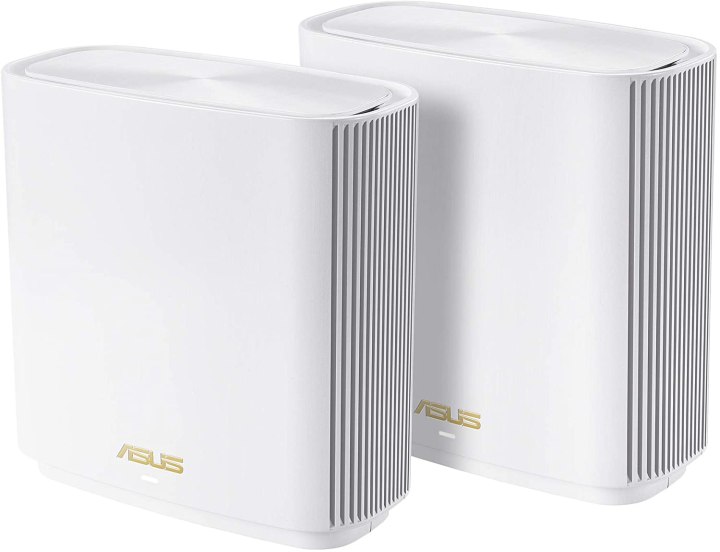
Best speedy Wi-Fi 6 mesh Wi-Fi system
Asus ZenWiFi XT8
- Fast Wi-Fi speeds
- Wi-Fi 6 support
- Intuitive app interface
- Expensive
- No three-pack bundle option for larger spaces
Why you should buy this: Asus's Zen WiFi pairs with the company's existing routers, making it easy to expand from a single router to a whole-home mesh network.
Who's it for: Gamers, home users, and 4K video streamers.
Why we picked the Asus Zen WiFi XT8:
Asus supports AiMesh software to make its ZenWiFi routers easy to operate and compatible with any additional routers that also have AiMesh, which means an older router may be able to help serve as a satellite device without extensive work, expanding coverage even farther beyond the 5,500-square-foot coverage the powerful router pack already offers. The router also comes with free parental controls and security software for extra management options.
The router system is Wi-Fi 6 and ready to provide all the latest features for compatible devices, including MU-MIMO direct connections, OFDMA data compression, and other improvements from faster Wi-Fi generations. Its three bands can provide a combined speed of 6,600Mbps.
The Asus ZenWiFi XT8 is another pricey model compared to a traditional router, but an excellent choice if you want a particularly powerful system that is ready with Wi-Fi 6 features.


Best mesh Wi-Fi system with integrated 5G backup
Netgear Orbi NBK752
- Built-in 5G for fast wireless speeds without fiber!
- Strong, reliable connection
- Wi-Fi 6 support
- Plenty of ports
- Expensive
Why you should buy this: You need fast broadband but live in an area not wired for fiber or cable Internet.
Who's it for: Gamers and streamers living in remote areas or those working on mission-critical projects requiring a backup Internet connection.
Why we picked the Netgear Orbi NBK752 Wi-Fi system:
For fast, reliable Wi-Fi coverage without needing a fiber, DSL, or cable Internet connection, you should look no further than Netgear's Orbi NBK752. This premium mesh Wi-Fi system is ideally suited for users who either reside in rural areas where a fast, wired broadband connection doesn't reach or anyone who needs a reliable home or office network with a 5G backup in case the main line goes down. This makes the Orbi NBK752 a very versatile mesh system supporting the latest connections, such as Wi-Fi 6 and 5G cellular over a Tri-band antenna for fast speeds. Though this isn't as mobile as a portable hotspot, the Orbi NBK752 can be used as a mobile command center for remote work, and speeds are fast enough for gaming, streaming, and video conferencing provided your wired or wireless network is fast enough.
The Orbi NBK752 maintains the line's design, which means it's not the most compact package. What you trade in terms of size though, you'll gain in coverage and signal strength — the larger size allows the unit to be outfitted with a large antenna. In terms of features, the NBK752 is very similar to the RBKE963 on our list, save for a more advanced quad-band Wi-Fi 6E support on the latter.

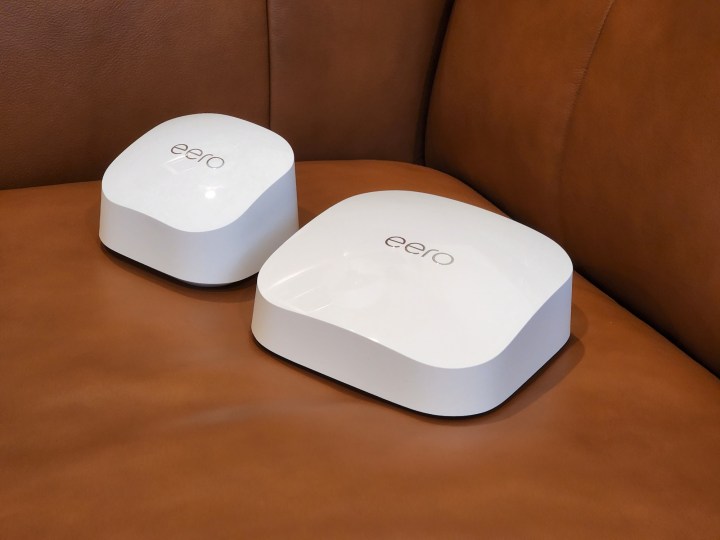
Best affordable Wi-Fi 6E mesh Wi-Fi system
Eero Pro 6E
- Supports fast, multigig connectivity
- Wi-Fi 6E onboard
- Easy to use and setup
- Great range
- Relatively affordable compared to competitors
- No quad-band design
- Late to the Wi-Fi 6E game
Why you should buy this: You want to upgrade to an advanced Wi-Fi 6E mesh system without breaking the bank.
Who's it for: Everyday home Internet users, streamers, and anyone with a fast home broadband plan.
Why we picked the Amazon Eero Pro 6E:
Amazon's latest flagship Eero Pro 6E is the company's newest addition to its Eero lineup of mesh networking router, bringing Wi-Fi 6E support at a relatively more affordable price into the home. While previous high-end mesh systems with Wi-Fi 6E support starts north of $1,000 for a multi-pack setup, the Eero Pro 6E delivers Wi-Fi 6E at a more modest price that tops out at $700 for a three-pack. Smaller homes can save money by going with a two-pack or single-pack configuration.
With the Eero Pro 6E, Amazon promises multi-gig speeds. Wired, you're going to find a multi-gig Ethernet port, which is ideal for gaming, high bandwidth streaming, and virtual reality applications, and you'll top out with gigabit speeds for wireless Wi-Fi connections. The company largely rectified all our complaints with its Wi-Fi 6-powered Eero 6 and Eero 6 Pro with the Eero Pro 6E, and we have nothing but great things to say about Amazon's latest mesh router in our review. If you're interested in upgrading to a Wi-Fi 6E mesh system without breaking the bank, the Eero Pro 6E should be high up on your list for its simple design, ease of use, and easy to set up design with the free smartphone app.

Frequently Asked Questions
While standard routers are often more affordable than mesh Wi-Fi systems, going with the latter allows you to have a much more reliable connection. Multiple nodes help to blanket your entire home with a good Wi-Fi signal, and mesh systems improve coverage and reliability. Additionally, many mesh Wi-Fi systems allow for a simple setup with intuitive, easy-to-use apps rather than an intimidating web-based user interface that's used by traditional routers. Many mesh networks come with support for MU-MIMO — or multiple user, multiple input, multiple output — support, which helps to keep data speeds fast when multiple devices are connected simultaneously to the network. This can help in households where you're streaming multiple video feeds and gaming. Even in smaller homes, you can opt to use a mesh system rather than a traditional router. Here, we recommend you use a single node instead of buying a multipack bundle with three nodes.
Oftentimes, the answer is yes. You'll need to have a modern smartphone or tablet running Apple's iOS or iPadOS or Google's Android OS. The requirements for which operating system version will be required will vary based on the mesh system you choose. Mesh systems require you to install a mobile app, create a login with a username and password, and then access the app to both set up the network and access your home Wi-Fi network's controls.
This will vary based on the device and manufacturer you choose. The mesh network app will give you basic and advanced controls, like the ability to either restart your network on-demand or create a schedule so that your network automatically restarts every week or every night. Many of the mesh systems allow you to either choose the band that's best for your device — either 2.4GHz or 5GHz — or give you the ability to manage band steering yourself manually. Wireless security, device usage reports, and parental controls are also features that you can set up. Parents can set up downtime, allowing them to restrict internet access to specific devices rather than turning off internet access for the whole house. Parents can also generate a usage log of how much traffic each specific device used during a specified period. And lastly, if you have visitors, you can also set up a guest network with its own specific SSID and password to log in, keeping your main network secure.
Fortunately, older mesh networks relying on Wi-Fi 5 technology — also known as 802.11ac — are coming down in price. If you don't have a fast enough broadband connection at home or you don't have Wi-Fi 6 devices, a Wi-Fi 5 mesh network will be more affordable, and some mesh devices, like those made by Vilo, are available in very affordable bundles that will allow you to create a true mesh network. Mesh systems from larger manufacturers generally start over $100 for a single node and can top out in the hundreds of dollars for multipack bundles.
If you choose to upgrade to a home mesh Wi-Fi system that uses Wi-Fi 6, also known as 802.11ax, you will need devices that are Wi-Fi 6 compatible. If you want to benefit from it more than just transferring files quickly over the network, you'll also want a very fast internet connection. Most households will be fine with Wi-Fi 5 mesh networks, as even basic fiber internet doesn't get close to saturating it. Even Wi-Fi 6 clients, like Samsung's flagship Galaxy S21 smartphones, are backward compatible to work on Wi-Fi 5 networks.
To get the most bang for your buck, check to see if the fastest speeds offered by your home broadband are within range of your mesh system. For example, while the Eero 6 supports speeds up to 500Mbps, the Eero 6 Pro tops out at gigabit speeds, making it more ideally suited for homes with fiber. If you have 400Mbps home internet, you'll be fine with the standard Eero 6, but investing in the more costly Pro model could future-proof your investment if you foresee yourself choosing a faster broadband plan down the road. Even though Wi-Fi 6 routers are only beginning to be adopted in the home, Wi-Fi 7 will eventually be its successor. Routers supporting the new Wi-Fi 7 standard are not, however, expected to hit the market until 2024.
In general, a single node will cover between 1,000 to 1,500 square feet of living space. If you own a smaller house or live in a small apartment, having a single node will be fine. But depending on the construction of your home, adding a second node to a small space could be beneficial. In particular, if you're running IoT devices, like a smart doorbell, having a second node near the door may be useful, as it can be difficult for Wi-Fi signals to penetrate the thick construction of your front door. Larger homes will likely need three or more nodes to extend the coverage to the garage and outdoor spaces, and you can add even more nodes to your network between what's available in three-pack bundles. Three nodes are generally recommended for homes with more than 4,000 square feet.
Connecting your media streaming box, gaming console, or home PC to a wired network produces a more reliable connection than a wireless connection, and some users may want the benefit of having an Ethernet connection to these devices. In general, while the main node often comes with an Ethernet port – to connect your main mesh node to your home modem – some companies, like Amazon's Eero, do not build Ethernet ports into their satellite nodes. This keeps things clean. To have Ethernet ports with Eero's system, for example, you'll need to purchase another main node and set it up on your network as a satellite node rather than use a dedicated satellite receiver. Other systems, like Orbi and Linksys's Velop, come with interchangeable satellites with built-in Ethernet ports to handle one or two wired connections.
Sometimes. Some routers have built-in compatibility with mesh networks so they can be linked to other compatible routers at a later date if necessary. The best example of this is probably Asus' AiMesh technology, which comes with its single router but can be used to set up a mesh network if necessary.
No. The router and nodes can connect wirelessly to get the job done. A satellite router will need access to a power source, but it won't need a connection to the primary router.
Each router will have its own instructions about this. Usually, they're designed to be about two rooms apart. Placement will also vary depending on what sort of dead zone you may want to fix, or where most mobile users will be congregating.




